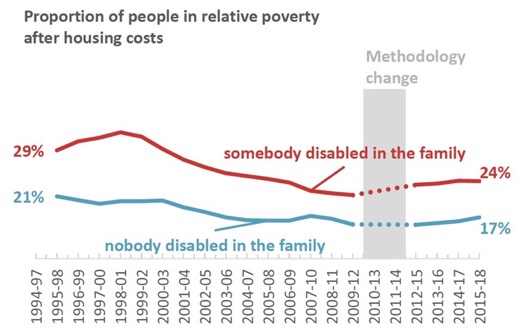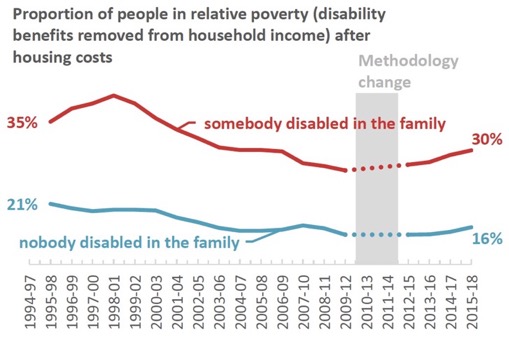Poverty and Income Inequality in Scotland 2015-18
Estimates of the number and proportion of people living in poverty in Scotland in 2015-18.
Disability and poverty
Chart 17. Relative poverty rates higher where a family member is disabled

Poverty rates remain higher for families in which somebody is disabled compared to those without. The gap between the two groups has remained fairly steady over the last few years.
In 2015-18, the poverty rate after housing costs for people in families with a disabled person was 24% (440,000 people each year). This compares with 17% (600,000 people) in a family without a disabled person.
The term 'family' here refers to the core family in a household, consisting of one or two adults and their dependent children if any.
If a household contains an extended family, for example including grandparents, these are treated as two separate family units for the purpose of the analysis.
Before housing costs data is available in the associated tables.
Due to changes in the way information on disabled people was collected, care should be taken when comparing the most recent years with years before 2012-15. Since 2012/13, disabled people are identified as those who report any physical or mental health condition(s) or illness(es) that last or are expected to last 12 months or more, and which limit their ability to carry out day-to-day activities.[1] Dashed lines in charts 17 and 18 indicate the period affected by the most recent change in methodology.
Additional living costs of disabled people
The previous measure of poverty doesn’t take into account the fact that additional living costs may be incurred due to the illness or disability in question. The analysis on the following page attempts to make an adjustment to the poverty rates to partly account for additional living costs for those households where someone is in receipt of disability benefits.
Chart 18. Relative poverty rates, with disability benefits removed from household income, higher where a family member is disabled

Whilst it is recognised that there are additional costs associated with disability, research shows that these vary greatly in level and nature, and there is no general agreement on how to measure these costs.
Analysis on this page excludes Disability Living Allowance, Attendance Allowance and Personal Independence Payments from total household income. These benefits are paid as a contribution towards the additional living costs for disabled people. If this income is excluded from total household income, then we are able to compare families with and without a disabled family member on a more like for like basis.
In 2015-18, as in previous years, the poverty rate was higher for individuals in families with a disabled person, when disability related benefits are not included in the household income. After housing costs, the poverty rate was 30% (550,000 people each year) for people with a disabled family member, and 16% (570,000 people) for those without a disabled family member.
Before housing costs data is available in the associated tables.
Excluding disability benefits from the analysis changes the poverty threshold. This is because some households now move down the income distribution, which lowers the median income and therefore also the poverty threshold. As a consequence, some families without a disabled person that were just below the poverty threshold in the previous analysis will now be above the threshold. As a result, the poverty rate for families without a disabled person is lower.
Contact
There is a problem
Thanks for your feedback